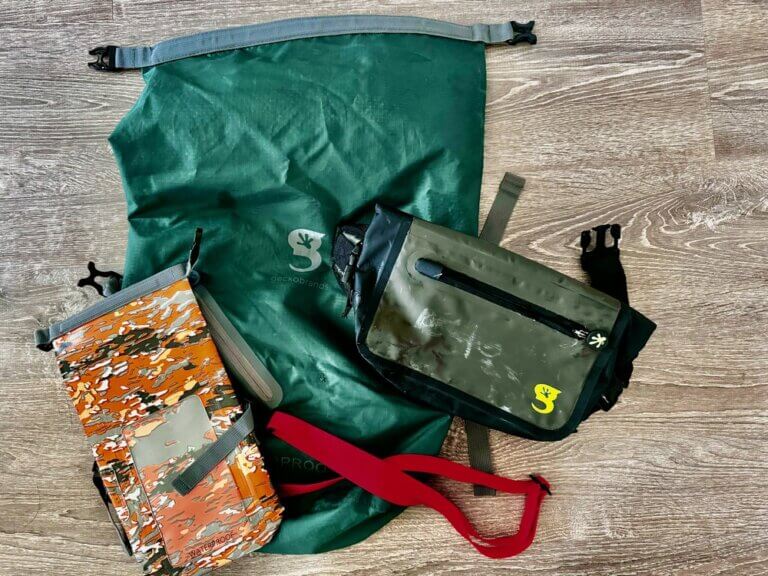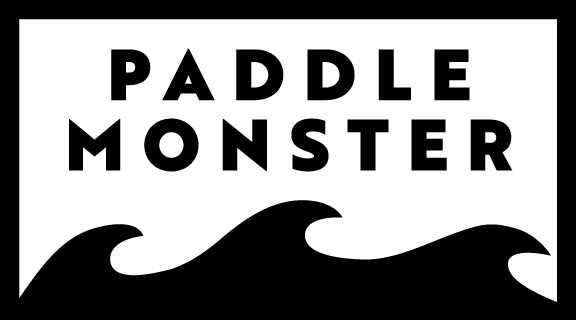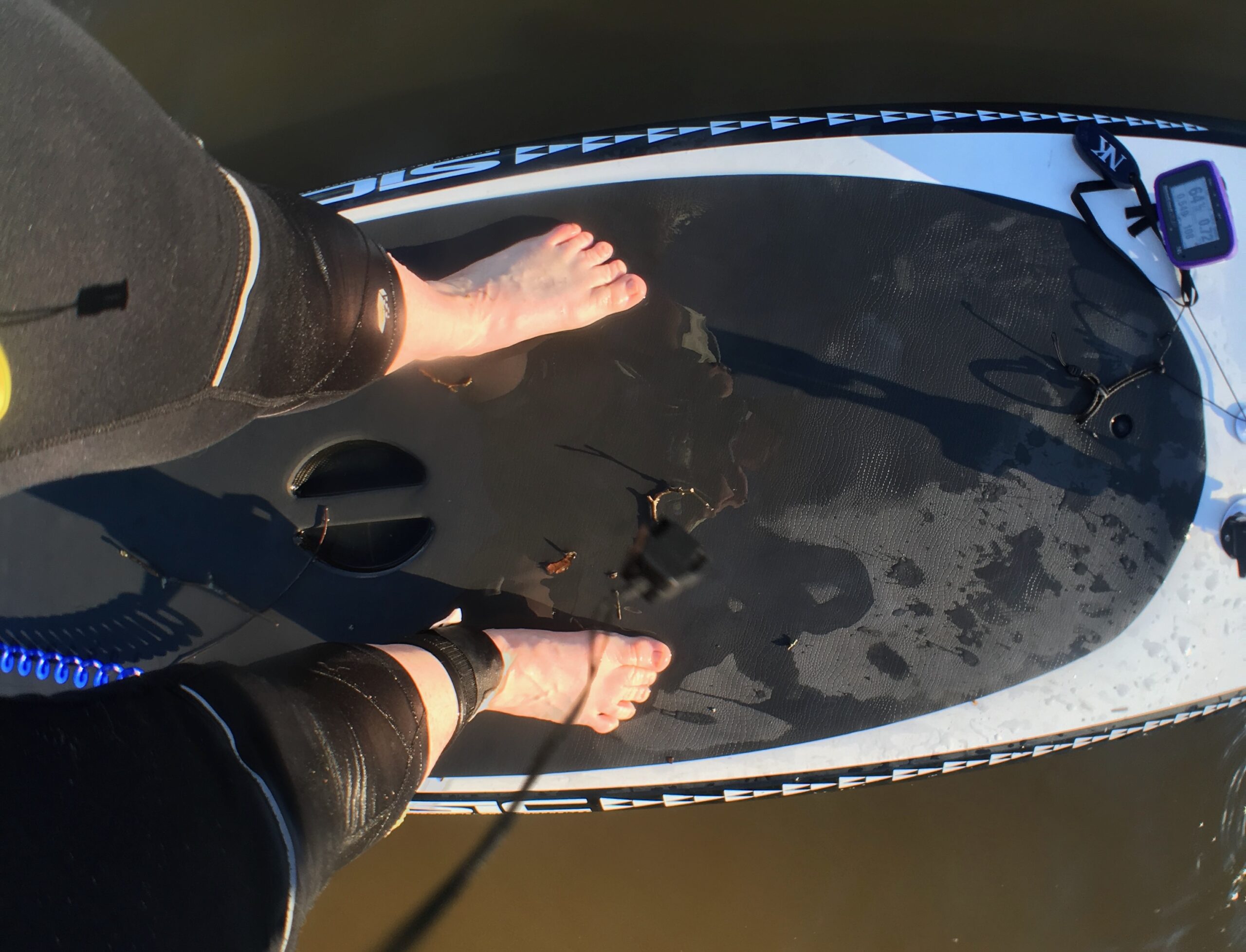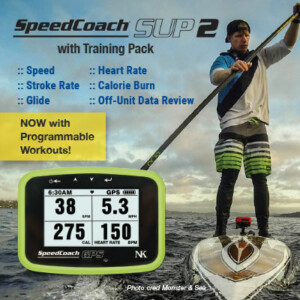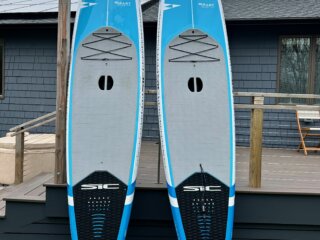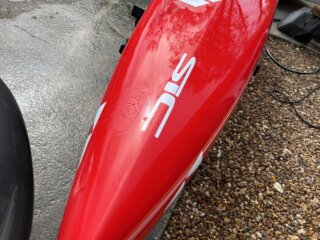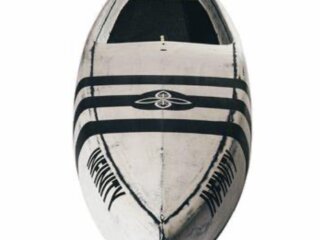
Paddling after a Long Winter
While many of you have been paddling all winter, I know there are probably just as many, particularly those living in more northern areas, who haven’t; certainly not with any regularity. This blog post is for those paddlers, to help them make the most of their first few weeks back on the water and set themselves up well for the coming season. That said, it’s also paddlers in any climate who, for one reason or another, may be returning to paddling after missing a substantial period of time on the water.
For years as a sprint canoe paddler I’d be frozen off the water from mid December (and sometimes earlier) to the beginning of March. I found that I couldn’t just get back on the water and hammer like I was able to in the fall, even if I was in fantastic shape from all the quality land-based training I’d done all winter. I needed a few weeks to reestablish comfort in my boat and my connection to the water. I just needed a little time to reorganize my technique and feel the nuances of how the boat was moving underneath me.
When I started paddling SUP, it was pretty much the same. Once the river froze and the winter’s deep freeze set in, I was off the water till sometime in March when I might be lucky enough to go south for some warm weather training. I experienced the exact same challenges getting back on my board as I did getting back into my canoe, and over the years I’ve discovered some things that make that process easier and allow me to paddle effectively much more quickly than I otherwise might.
Paddling all winter vs. time off the water
The main reason I think it is important to try to paddle two to three times per week through the winter is that it allows you to maintain your feel for the water and your command of sound technique. It can even provide you an opportunity to develop better technique while focusing on other important elements of SUP training like strength and aerobic fitness, which can best be developed on land.
However, many people in colder climates are unable to paddle at all in the winter. If that is you, you shouldn’t despair. It’s possible for you to very quickly feel good on your board and on top of your technique by taking an intelligent approach to getting back on the water and by paying attention to some critical details. This is especially true if you’ve done your homework all winter by doing your fitness training on land.
Getting back on the water
The first few paddles you do when getting back on the water after a prolonged period off the water should be a little shorter than what you might normally do. No matter how hard you’ve trained over the winter, you’re doing an activity you haven’t done in a while and that places unique demands on your muscles, connective tissue and nervous system. Give yourself a few workouts, or more realistically a week or two, to get them used to these demands before entertaining any ideas of doing high volume work.
I’ve always found the best way to reacquaint my body with the demands of paddling is to paddle on flat water if possible. Going out and chasing bumps (no matter how much fun it looks like) when you haven’t paddled for months is probably jumping the gun. You’ll be risking injury and won’t be establishing sound movement patterns that will form the foundation of your technique for the coming season. You’d be better off spending a little time in calm, flat water focusing on feeling the water on your blade and the board’s response to what you do with your paddle rather than bouncing around in waves. Just as this allows you to more easily reacquaint yourself with effective technique, the stability and consistency of paddling in flat water reduces the risk of taking an awkward, yet fully loaded stroke that can cause injury.
Even at the best of times, when you have your technique really locked down and feel like you’re paddling extremely effectively, it’s often a challenge to feel technically sound in big water. You sort of just focus on loading and unloading weight on your blade and maintaining some rhythm to your paddling (or matching your rhythm to the ocean). So, when you’re just getting back on the water after a prolonged period and your priority should be re-establishing effective technique, it’s probably not a great idea to spend a lot of time on the ocean initially. Instead, your objective should be to pull as many really good strokes as possible where you can confidently load water on your blade and hold it there through the stroke, feeling yourself lift the board and pulling it forward across the water and past the paddle. In my experience, this is more easily done (at least initially) in flat water.
Of course, one of the things you’re going to find after not paddling all winter is that even if you feel like you can really paddle well, you won’t feel like you can paddle well for very long. You can be incredibly fit after a winter of working hard on aerobic fitness, power and power endurance, however your nervous system isn’t finely tuned for paddling after time off the water. It’s going to be working extra hard to control a paddling movement that it’s not as familiar with as it normally is. It’s going to get tired more quickly than normal, and as it does, you’re going to feel like your technique deteriorates and your connection weakens, causing your board to sink deeper in the water and not move across the water as easily or quickly as it was just a few strokes before. In my opinion, the best thing to do when you’re just getting back on the water and encounter this sensation is stop.
Trying to continue to paddle when the wheels are clearly falling off your technique due to nervous system fatigue is a mistake. You’re doing yourself no favors by continuing to hammer away with poor strokes. All you’re doing is reinforcing poor movement patterns.
When you’re learning anything, it takes literally tens of thousands of quality repetitions to master it, whether it is a physical skill or something intellectual like conjugating verbs in a different language. This is certainly the case for a good paddling stroke. If you end up taking inferior strokes because you’re tired, you’re not imprinting good strokes on your nervous system’s motor memory and control of your paddling. What you’re doing is actually counter productive as it is instead imprinting bad strokes on your neuromuscular control.
What I suggest when just getting back on the water is taking as many “perfect” strokes as possible and then stopping once you feel the quality of each stroke deteriorate. When this happens to me, I stop, rest for as little as 30 seconds or as much as a minute or two, let my muscles and nervous system relax, and refocus on exactly on what I want to do each stroke and how I want it to feel. Then I start again, paddling with perfect strokes for as long as I can until I feel them start to deteriorate again.
At first, I might only be able to take 10 or 15 strokes before stopping. Gradually over the course of a few days or maybe a week, I get to the point where I can hold what I feel are effective strokes for an extended period. Only then am I ready to consider doing work that requires me to paddle for set periods of time.
But what about doing the scheduled workouts?
If you’re training on a group program or have a coach that is prescribing you work, there is a strong possibility that you can find yourself just starting out on the water and following a program that’s asking you to do more than you are ready for from the perspective of technique. So, what should you do?
There are two different approaches I’d suggest, and both can work equally well to get you to the point where you’re technique feels sound and consistent and you’re ready to do hard work.
The first is to work with your coach and modify the workouts to better fit your individual needs. He or she can help you adjust the training sessions for a week or two so that they’ll better help you organize your technique and better feel both the water on your blade and the movement of your board across the water. The advantage of this approach is that not only does it ensure you’re on a program that best meets your unique needs, but it also provides you the opportunity to ask lots of questions of your coach that might help you enhance your technique and learn to paddle even better.
I find that in this approach, the best work a coach can prescribe is “as you feel” paddling, where the paddler is asked to paddle at level 2 effort “as they feel”. If they feel great and feel like they are paddling with consistency, they can do more work or longer pieces. If they feel their technique is sloppy and inconsistent, they are better off paddling for shorter periods, stopping when they feel like their technique is really unraveling.
The second approach is a little more independent but works equally well. It just won’t provide you with the ongoing conversation with your coach, and as such won’t give you the opportunity to ask questions when they come to mind.
This approach involves modifying the program yourself. It’s an approach I’ve often used and here’s how I do it. If the workout is, for example, 6 x 10 min at level 2 with 1 min rest, I’ll start a 10 min piece at level 2 paddling as perfectly as I can for as long as I can. When I feel like my technique is falling apart I stop, or at the very least slow way down, for 15 to 30 seconds or even 1 minute before getting back into my level 2 pace and again paddling as perfectly as possible. I repeat this process for the entire 10-minute piece, then take the prescribed rest. Then I do the same thing again for the next 10 minute piece and for the rest of the 6 x 10 min workout.
Though I’m not doing the workout properly from a physiological sense because I’m not staying in zone 2 consistently, I’m doing it correctly for this point in my development from a technical sense. At this point in the season that is what is most important. Your primary goal should be to re-establish effective technique as quickly as possible rather than cranking out hard work. There’s lots of time to work hard in the weeks and months ahead.
I’ve seen lots of extremely strong and fit paddlers that don’t paddle very well. They aren’t nearly as fast as they should be. I’ve also seen paddlers who truthfully aren’t very strong and could be in better shape that paddle very well. They are always faster than you’d expect them to be. Technique is extremely important. By taking the approach I’m advocating here, I’m taking steps to ensure I’ve first and foremost laid good foundations of technique that I can build on for the entire season ahead.
If you take this approach and stop when needed during the “work”, you’re really only slightly altering it. The “training effect” from a physiological approach is only very slightly affected. You’re still spending most of your time in each piece in the required training zone. At the same time, you’re making a profound difference when it comes to establishing effective technique.
If I haven’t paddled for all or most of a winter, I usually take this approach for a couple of weeks. After a week or two of developing comfort with my motion and getting the paddling muscles and connective tissue ready, I can start to do the program properly. However, I still closely monitor my technique and if I feel something is really amiss, I stop, refocus and start again, making sure I’m paddling with optimal technique before I try to grind out a long workout. Before you know it, by taking this approach, you’re ready to do all the work on the program and can paddle well while you do it.
I find that by being both smart and patient like this in the first few weeks back on the water you can greatly reduce the risk of injury and increase the chances of developing really good technique that will be foundational for the entire season.
Tips for preparing for paddling in winter training even if you’re frozen off the water
- Do your winter homework with effective land-based training. This should consist of lots of aerobic base work and power and power endurance work in the gym. It makes the transition to getting back to the water much easier. The fitter you are and the greater your aerobic base and power endurance, the easier paddling is going to feel. Your technique might not feel super sharp, but you’ll have the fitness to pull strokes for an hour or so without feeling exhausted. This allows you to work on your technique more effectively.
- Do your land drills. Spending even the smallest amount of time doing land drills regularly through the winter will help you reestablish your connection and effective technique much more quickly once you get back on the water.
If your technique is already sound, your land drills will help to consolidate that sound technique even though you aren’t on the water yet. They will help you reestablish your effective technique much more quickly once you’re back on the water.
If your technique needs work and there are adjustments or corrections that you’ve identified in the fall, you can actually work on them through the winter in the land drills. Remember, land drills put you into the proper positions on land so that they become easier to find on the water. You can correct your positioning in the land drills and begin to reteach movement patterns using these drills, making the process of establishing a new or modified technique on the water much quicker.
- Watch video and use visualization. A big part of paddling better is understanding precisely what good paddling is and what it looks like. This understanding is easy to acquire in the winter when you’re frozen off the water because some of the time you’d normally spend paddling can be devoted to video and visualization.
Having this understanding and knowing what good paddling looks like is going to help you do that land drills better. And if you can do them better, with more precision and attention to detail with regards to your positioning, they are going to help you find an effective motion and connection more quickly when you get back on the water.
Tips for paddling more effectively once you’re back on the water
- Start off with shorter paddles than you’d normally do. No matter how hard you trained over the winter, if you haven’t paddled regularly for a few months, your nervous system is going to take a while to adjust the challenge of controlling your paddling movements again.
If your paddles normally last for 70 to 80 minutes in the summer, start with paddles of about 35 to 40 minutes for a few days. Your nervous system will be able to handle these shorter paddles and should be able to very effectively adjust to finding the positions it’s familiar with from the land drills on a moving board. However, after about 40 minutes it’s going to start to get tired and will have more difficulty controlling your movement. You’re more likely as this point to start paddling poorly, or at least not as well. You’re doing yourself no favors paddling poorly. In fact, you’re negating the positive imprinting you will have done on your nervous system in the first 40 minutes of your paddle. You’re better off getting off the water before this happens while your stroke still feels good.
- Gradually increase the length of your sessions to full length. Take your time. There’s no rush. Listen to your body and its ability to control your technique and your feel for the water. It will tell you when you’re ready to lengthen your workouts. You’ll know because it will start to get easy to control both your technique and your connection for increasingly longer periods of time.
- Paddle as perfectly as you can, focusing on both an effective connection and board movement. When you feel either deteriorate, stop, refocus and start again after a brief rest.
- Gradually try to paddle for longer stretches without having to stop, but always with consideration for technique and board movement. Just like making your total time on the water longer, take your time and be patient with this. Listen to your body and its ability to control technique and connection.
- If possible, work with your coach to modify the training program to accommodate your return to the water. A good coach might be able to structure the first few workouts with drills and paddling work that makes establishment of connection and an effective motion the priority. This saves you from having to adjust your training program yourself or design and set up your own workouts. Both can add stress and a feeling of uncertainty to what you are doing, and training is generally more effective without either.
- If unable to work with a coach to modify the training program to accommodate your return to the water, do the prescribed work but don’t be afraid to stop. The work at this point is almost irrelevant. Technique trumps work at this point. Stop and refocus when connection or board movement deteriorates.
- Gradually over a one to three-week period (depending on your experience and skill level) start to do the workouts on the program as designed. But always keep tuned into your connection and how the board is moving underneath you. If necessary, stop and refocus as you were in the first week or so. You’re better to be patient with getting to the work and paddling well than you are rushing this process.
- Use resistance on your board to help feel the water better. This has been discussed at length in a previous issue of The Catch. Resistance slows the board down enough that it becomes easier to find and feel connection, while at the same time enhancing muscle awareness in the stroke. Both are extremely beneficial when returning to the water after a long layoff. You’ll just want to make sure you don’t overuse your resistor. Your muscles and connective tissue are already dealing with loading they are not used to after your layoff. Adding extra load by using a resistor is safe in small amounts, but can be dangerous if done too much. Your risk of injury will increase dramatically.
- Stretch immediately after each paddling session. Using your muscles differently than they are used to is going to leave them tight, stiff and a little sore. Expect to deal with some delayed onset muscle stiffness after your first paddling session. Muscles that are stiff and tight are going to be harder to recruit and control than ones that are loose and supple. It is extremely important that you do everything you can between sessions to keep your muscles loose and supple to enhance the learning during the first few paddling sessions. You’ll accelerate the process of getting back to full paddling form if you do.
- If you have a chance, collect video of your paddling as soon as possible on your return to the water. It can help you identify areas for improvement early before any bad habits form. It can also serve as a baseline against which your technique can be compared over the course of the year.
Enjoy the Experience!
The return to the water in the spring after a long winter off the water is an amazing time. Getting a paddle in your hand again and getting back on your board is like being reunited with a long lost friend that you always have fun with.
While it can be hard and frustrating as you try to recapture feelings you had when you were last on your board months ago, being patient and relaxed can help you recapture these feelings more quickly than you otherwise might. It can also help prevent injuries that can trouble you for the entire season. It’s okay to take your time adjusting to getting back on your board. In fact it’s advisable to take a couple of weeks to settle into the on-water training.
You can’t go wrong by taking a little time to get your technique organized when getting back on the water. Focusing on your connection and the movement of the board underneath you not only helps you establish better technique more quickly, but it also creates a good habit that is useful at all times when you’re paddling.
Happy paddling!
Paddle Events
DeSatnick Foundation Around the Cape Paddle
Ohio River Paddlefest Races
The Circumnavigation-Tilghman Island 2024
Recent Classifieds
2 Boards: Both SIC Bullet 12’6″ x 28.5″
- Sell
- 5 hours ago
- Stand Up Paddleboard
- 02813 Charlestown , Rhode Island United States
- 5 views
SIC XRS 14 x 22
- Sell
- 4 days ago
- Stand Up Paddleboard
- Chattanooga , Tennessee United States
- 47 views
Wanted! Ocean / downwind 14 foot SUP
- Buy
- 4 days ago
- Stand Up Paddleboard
- Main Street , 07005 Boonton , New Jersey United States
- 45 views
one edge pro 2.0 hollow 14′ x 23.5”
- Sell
- 5 days ago
- Stand Up Paddleboard
- 53066 Oconomowoc , Wisconsin United States
- 88 views
2021 Starboard Allstar 14×24 5
- Sell
- 7 days ago
- Stand Up Paddleboard
- 21085 Joppatowne , Maryland United States
- 89 views
Subscribe for Premium Content and Coaching
Join the Paddle Monster paid Plan Today!
You May Also Like


Paddle Foundations: The Six Fundamentals of Paddle Technique
